International Journal of Information Technology and Computer Science @ijitcs
Статьи журнала - International Journal of Information Technology and Computer Science
Все статьи: 1254
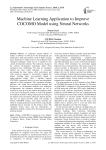
Machine learning application to improve COCOMO model using neural networks
Статья научная
Millions of companies expend billions of dollars on trillions of software for the development and maintenance. Still many projects result in failure causing heavy financial loss. Major reason is the inefficient effort estimation techniques which are not so suitable for the current development methods. The continuous change in the software development technology makes effort estimation more challenging. Till date, no estimation method has been found full-proof to accurately pre-compute the time, money, effort (man-hours) and other resources required to successfully complete the project resulting either over-estimated budget or under-estimated budget. Here a machine learning COCOMO is proposed which is a novel non-algorithmic approach to effort estimation. This estimation technique performs well within their pre-specified domains and beyond so. As development methods have undergone revolutionaries but estimation techniques are not so modified to cope up with the modern development skills, so the need of training the models to work with updated development methods is being satiated just by finding out the patterns and associations among the domain specific data sets via neural networks along with carriage of desired COCOMO features. This paper estimates the effort by training proposed neural network using already published data-set and later on, the testing is done. The validation clearly shows that the performance of algorithmic method is improved by the proposed machine learning method.
Бесплатно

Man-made Object Detection Based on Texture Clustering and Geometric Structure Feature Extracting
Статья научная
Automatic aerial image interpretation is one of new rising high-tech application fields, and it’s proverbially applied in the military domain. Based on human visual attention mechanism and texture visual perception, this paper proposes a new approach for man-made object detection and marking by extracting texture and geometry structure features. After clustering the texture feature to realize effective image segmentation, geometry structure feature is obtained to achieve final detection and marking. Thus a man-made object detection methodology is designed, by which typical man-made objects in complex natural background, including airplanes, tanks and vehicles can be detected. The experiments sustain that the proposed method is effective and rational.
Бесплатно
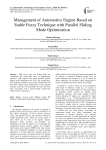
Статья научная
Both fuzzy logic and sliding mode can compensate the steady-state error of proportional-derivative (PD) method. This paper presents parallel sliding mode optimization for fuzzy PD management. The asymptotic stability of fuzzy PD management with first-order sliding mode optimization in the parallel structure is proven. For the parallel structure, the finite time convergence with a super-twisting second-order sliding-mode is guaranteed.
Бесплатно

Management of Possible Roles for Distributed Software Projects Using Layer Architecture
Статья научная
Several members are involved in development and management of the Distributed Software Projects. Each member needs to know the responsibilities of each other for proper management of the activities of such distributed projects to produce coherent outcomes. Distribution middleware software has higher-level distributed programming models whose reusable APIs (application programming interface) and components automate and extend native operating system capabilities. Software management tools like Work break-down structure (WBS), Gantt chart, Critical Path Method, and Critical Chain Method etc. does not fully help the managers to manage the member's responsibilities during the development of distributed applications. The layered architecture can help to do so. This style not only gives the layer level description of the activity involved, it also defines and directs the group of workforce. By listing the groups of workforce, the development team as well as the customer can know the activity and the member involved to work on those specific activities. This layered architecture is much benefited to development team and also to numbers of stakeholder of the large distributed project. The extended new approach of layer pattern with 'Responsibility Index' adds extra value to manage all the members' responsibilities. Managers, stakeholders and others can have an easy management system. The request or complaint from the customer can be passed to appropriate team without much delay. Most importantly this will give facility to collect timely feedback from all levels of customers.
Бесплатно
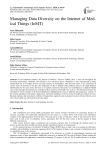
Managing Data Diversity on the Internet of Medical Things (IoMT)
Статья научная
In the healthcare industry, the Internet of Medical Services (IOMT) plays a vital role throughout the increasing performance, reliability, and efficiency of an electronic device. Healthcare is also characterized as being complicated due to its highly diverse and large number of shareholders. Data diversity refers to the continuum of various types of elements in the data. The integration of data is difficult where different sources can adopt different identification for the same entity, but there is no explicit connection. Researches are contributing to a digitized Health care system through interconnections available medical resources and health care services. This Research presents the contribution of IoT to people in the field of Healthcare, highlighting the issues in different data integration, analysis of the existing algorithms and models, applications, and future challenges of IoT in terms of healthcare medical services. Big data analytics that incorporates millions of fragmented, organized, and unstructured sources of data will play a key role in how health care will be delivered in the future.
Бесплатно
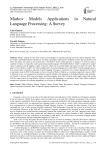
Markov Models Applications in Natural Language Processing: A Survey
Статья научная
Markov models are one of the widely used techniques in machine learning to process natural language. Markov Chains and Hidden Markov Models are stochastic techniques employed for modeling systems that are dynamic and where the future state relies on the current state. The Markov chain, which generates a sequence of words to create a complete sentence, is frequently used in generating natural language. The hidden Markov model is employed in named-entity recognition and the tagging of parts of speech, which tries to predict hidden tags based on observed words. This paper reviews Markov models' use in three applications of natural language processing (NLP): natural language generation, named-entity recognition, and parts of speech tagging. Nowadays, researchers try to reduce dependence on lexicon or annotation tasks in NLP. In this paper, we have focused on Markov Models as a stochastic approach to process NLP. A literature review was conducted to summarize research attempts with focusing on methods/techniques that used Markov Models to process NLP, their advantages, and disadvantages. Most NLP research studies apply supervised models with the improvement of using Markov models to decrease the dependency on annotation tasks. Some others employed unsupervised solutions for reducing dependence on a lexicon or labeled datasets.
Бесплатно

Mask R-CNN for Geospatial Object Detection
Статья научная
Geospatial imaging technique has opened a door for researchers to implement multiple beneficial applications in many fields, including military investigation, disaster relief, and urban traffic control. As the resolution of geospatial images has increased in recent years, the detection of geospatial objects has attracted a lot of researchers. Mask R-CNN had been designed to identify an object outlines at the pixel level (instance segmentation), and for object detection in natural images. This study describes the Mask R-CNN model and uses it to detect objects in geospatial images. This experiment was prepared an existing dataset to be suitable with object segmentation, and it shows that Mask R-CNN also has the ability to be used in geospatial object detection and it introduces good results to extract the ten classes dataset of Seg-VHR-10.
Бесплатно
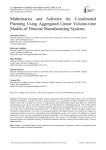
Статья научная
The problems of managing modern complex organizational and manufacturing systems, such as international production corporations, regional economies, sectoral ministries, etc., in conditions of fierce competition are primarily related to the need to consider the activity of organizational and manufacturing objects that make up a multi-level manufacturing system, that is, the ability to efficiently solve the problem of coordinating interests. This problem cannot be solved efficiently without the use of modern scientific achievements and appropriate software. As an example, we can cite the active systems theory pioneered by Prof. V. M. Burkov and his students, which successfully claims to be a constructive implementation of the idea of coordinated planning. This paper proposes new models and methods of coordinated planning of two-level organizational and manufacturing systems. Our models and methods use original compromise criteria and the corresponding constructive algorithms. The original aggregated volume-time models are used as models of organizational and manufacturing objects. We present a well-founded software structure for the proposed methods of coordinated planning. It contains an intelligent interface for using the presented results in solving applied problems.
Бесплатно
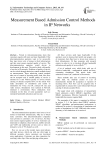
Measurement Based Admission Control Methods in IP Networks
Статья научная
Trends in telecommunications show that customers require still more and more bandwidth. If the telecommunication operators want to be successful, they must invest a lot of money to their infrastructure and they must ensure required quality of service. The telecommunication operators would devote to development in this area. The article deals with quality of service in IP networks. Problems of quality of service can be solved through admission control methods based on measurements. These admission control methods take care of control of incoming traffic load. New flow can be accepted only if needed quality of service is ensured for it and without quality of service breach causing of already accepted flows. In the article were made description of simulations and results of simulations for Voice over IP, constant bit rate and video sources. Simulations were realized in Network simulator 2 environment. These simulations were evaluated on the base of some parameters such as: estimated bandwidth, utilization and loss rate.
Бесплатно

Measurement of Usability of Office Application Using a Fuzzy Multi-Criteria Technique
Статья научная
Software Quality is very important aspect for any software development company. Software quality measurement is also a major concern for improving the software applications in software development processes in these companies. The quantification of various quality factors and integrate them into various software quality models is very important to analyze the quality of software system. Software usability is one of the important quality factors now days due to the increasing demand of interactive and user friendly software systems. In this paper, an attempt has been made to quantifying the usability of Ms-Excel 2007 and Ms-Excel 2010 application software using ISO/IEC 9126 model and compare the numeric value of usability for both version of Ms-Excel 2007 and Ms-Excel 2010. Due to the random nature of the usability attributes, the fuzzy multi criteria decision technique has been used to evolve the usability of the software office application. The present method will be helpful to analyze and enhance the quality of interactive software system.
Бесплатно
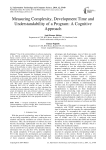
Measuring Complexity, Development Time and Understandability of a Program: A Cognitive Approach
Статья научная
One of the central problems in software engineering is the inherent complexity. Since software is the result of human creative activity and cognitive informatics plays an important role in understanding its fundamental characteristics. This paper models one of the fundamental characteristics of software complexity by examining the cognitive weights of basic software control structures. Cognitive weights are the degree of the difficulty or relative time and effort required for comprehending a given piece of software, which satisfy the definition of complexity. Based on this approach a new concept of New Weighted Method Complexity (NWMC) of software is developed. Twenty programs are distributed among 5 PG students and development time is noted of all of them and mean is considered as the actual time needed time to develop the programs and Understandability (UA) is also measured of all the programs means how much time needed to understand the code. This paper considers Jingqiu Shao et al Cognitive Functional Size (CFS) of software for study. In order to validate the new complexity metrics we have calculated the correlation between proposed metric and CFS with respect to actual development time and performed analysis of NWMC with CFS with Mean Relative Error (MRE) and Standard Deviation (Std.). Finally, the authors found that the accuracy to estimate the development time with proposed measure is far better than CFS.
Бесплатно
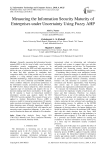
Measuring the information security maturity of enterprises under uncertainty using fuzzy AHP
Статья научная
Generally, measuring the Information Security maturity(ISM) is the first step to build a new knowledge information security management system in an organization. Knowing the ISM level helps organizations decide the type of protection strategies and policies will be taken and their priorities to strengthen their competitive ability. One of the possible ways to solve the problem is a using multiple criteria decision-making (MCDM) methodology. Analytic hierarchy process (AHP) is one of the most commonly used MCDM methods, which combines subjective and personal preferences in the information security assessment process. However, the AHP involves human subjectivity, which introduces vagueness type of uncertainty and requires the use of decision-making under those uncertainties. In this paper, the IS maturity is based on hierarchical multilevel information security gap analysis model for ISO 27001:2013 security standard. The concept of fuzzy set is applied to Analytic Hierarchical Process (AHP) to propose a model for measuring organizations IS maturity under uncertain environment. Using fuzzy AHP approach helps determine more efficiently importance weights of factors and indicators, especially deal with imprecise and uncertain expert comparison judgments. A case study is used to illustrate the better new method for IS evaluation.
Бесплатно
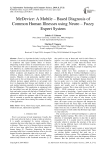
Medevice: a mobile – based diagnosis of common human illnesses using neuro – fuzzy expert system
Статья научная
Fever is a sign that the body is trying to fight infection. It is usually accompanied by various sicknesses or symptoms that signal another illness or disease. Diagnosing it ahead of time is essential because it has to do with human life and to determine what to do to get well. MeDevice is a mobile-based application that runs in Android devices that allows the user to enter the levels of his/her symptoms and diagnoses the disease either as influenza, dengue, chicken pox, malaria, typhoid fever, measles, Hepatitis A and pneumonia together with its details and its first aid treatment. It aims at providing an efficient decision support platform to aid people with fever in diagnosing their disease and whether or not to seek medical attention especially in developing countries like the Philippines. This application is engineered with the knowledge base and the inference method of fuzzy logic and expert system with the help of Gradient Descent optimization algorithm and back propagation neural network to achieve the optimum value of the error rate. This is essential to provide the application with a high accuracy rate which shows during the conduct of testing of the application.
Бесплатно
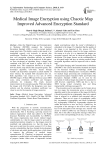
Medical image encryption using chaotic map improved advanced encryption standard
Статья научная
Under the Digital Image and Communication in Medicine (DICOM) standard, the Advanced Encryption Standard (AES) is used to encrypt medical image pixel data. This highly sensitive data needs to be transmitted securely over networks to prevent data modification. Therefore, there is ongoing research into how well encryption algorithms perform on medical images and whether they can be improved. In this paper, we have developed an algorithm using a chaotic map combined with AES and tested it against AES in its standard form. This comparison allowed us to analyse how the chaotic map affected the encryption quality. The developed algorithm, CAT-AES, iterates through Arnold’s cat map before encryption a certain number of times whereas, the standard AES encryption does not. Both algorithms were tested on two sets of 16-bit DICOM images: 20 brain MRI and 26 breast cancer MRI scans, using correlation coefficient and histogram uniformity for evaluation. The results showed improvements in the encryption quality. When encrypting the images with CAT-AES, the histograms were more uniform, and the absolute correlation coefficient was closer to zero for the majority of images tested on.
Бесплатно
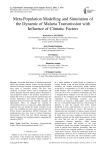
Статья научная
We model the dynamic of malaria transmission taking into account climatic factors and the migration between Douala and Yaounde´, Yaounde´ and Ngaounde´re´, three cities of Cameroon country. We show how variations of climatic factors such as temperature and relative humidity affect the malaria spread. We propose a meta-population model of the dynamic transmission of malaria that evolves in space and time and that takes into account temperature and relative humidity and the migration between Douala and Yaounde´, Yaounde´ and Ngaounde´re´. More, we integrate the variation of environmental factors as events also called mathematical impulsion that can disrupt the model evolution at any time. Our modelling has been done using the Discrete EVents System Specification (DEVS) formalism. Our implementation has been done on Virtual Laboratory Environment (VLE) that uses DEVS formalism and abstract simulators for coupling models by integrating the concept of DEVS.
Бесплатно

Metal Artifact Reduction from Computed Tomography (CT) Images using Directional Restoration Filter
Статья научная
Computed tomography angiography (CTA) is a stabilized tool for vessel imaging in the medical image processing field. High-intense structures in the contrast image can seriously hamper luminal visualization. Metal artifacts are an extensive problem in computed tomography (CT) images. We proposed directional restoration filtering process with Fuzzy logic in order to reduce metal artifact from CT images. We create two sets by iteration process and these sets will be sorted in ascending order. After sorting we take two elements from two data sets and the tracking both elements will be selected from the second position of those sorting arrays. Intersection Fuzzy logic will be executed between two selected elements and Gaussian convolution operation will be performed in the entire images because of enhancement the artifact affected CT images. In this paper, we investigated a fully automated intensity-based filter and it depends on the gray level variation rating. This results in a better visualization of the vessel lumen, also of the smaller vessels, allowing a faster and more accurate inspection of the whole vascular structures.
Бесплатно
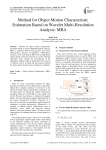
Method for Object Motion Characteristic Estimation Based on Wavelet Multi-Resolution Analysis: MRA
Статья научная
Method for object motion characteristic estimation based on wavelet Multi-Resolution Analysis: MRA is proposed. With moving pictures, the motion characteristics, direction of translation, roll/pitch/yaw rotations can be estimated by MRA with an appropriate support length of the base function of wavelet. Through simulation study, method for determination of the appropriate support length of Daubechies base function is clarified. Also it is found that the proposed method for object motion characteristics estimation is validated.
Бесплатно
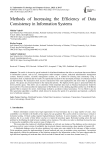
Methods of Increasing the Efficiency of Data Consistency in Information Systems
Статья научная
The article is devoted to special methods for distributed databases that allow to accelerate data reconciliation in information systems, such as IoT, heterogeneous multi-computer systems, analytical administrative management systems, financial systems, scientific management systems, etc. A method for ensuring data consistency using a transaction clock is proposed and the results of experimental research for the developed prototype of a financial system are demonstrated. The transaction clock receives transactions from client applications and stores them in appropriate queues. The queues are processed based on the transaction priority. The highest priority queue is processed before the lowest priority queue. This allows you to determine which important data (such as financial transactions) should be processed first. The article justifies the replacement of the Merkle tree with a hashing algorithm and the use of the Bloom spectral filter to improve the Active Anti-Entropy method to accelerate eventual consistency. For its effective use, the filter generation algorithm is modified, which allowed to increase the speed of its generation and maintain a sufficient level of collision resistance.
Бесплатно
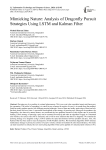
Mimicking Nature: Analysis of Dragonfly Pursuit Strategies Using LSTM and Kalman Filter
Статья научная
Pursuing prey by a predator is a natural phenomenon. This is an event when a predator targets and chases prey for consuming. The motive of a predator is to catch its prey whereas the motive of a prey is to escape from the predator. Earth has many predator species with different pursuing strategies. Some of them are sneaky again some of them are bolt. But their chases fail every time. A successful hunt depends on the strategy of pursuing one. Among all the predators, the Dragonflies, also known as natural drones, are considered the best predators because of their higher rate of successful hunting. If their strategy of pursuing a prey can be extracted for analysis and make an algorithm to apply on Unmanned arial vehicles, the success rate will be increased, and it will be more efficient than that of a dragonfly. We examine the pursuing strategy of a dragonfly using LSTM to predict the speed and distance between predator and prey. Also, The Kalman filter has been used to trace the trajectory of both Predator and Prey. We found that dragonflies follow distance maintenance strategy to pursue prey and try to keep its velocity constant to maintain the safe (mean) distance. This study can lead researchers to enhance the new and exciting algorithm which can be applied on Unmanned arial vehicles (UAV).
Бесплатно
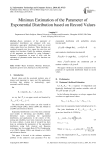
Minimax Estimation of the Parameter of Exponential Distribution based on Record Values
Статья научная
Bayes estimators of the parameter of exponential distribution are obtained with non-informative quasi-prior distribution based on record values under three loss functions. These functions are weighted squared error loss, square log error loss and entropy loss functions. Finally the minimax estimators of the parameter are obtained by using Lehmann’s theorem. Comparisons in terms of risks with the estimators of parameter under three loss functions are also studied.
Бесплатно

